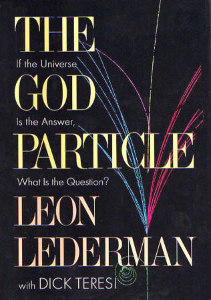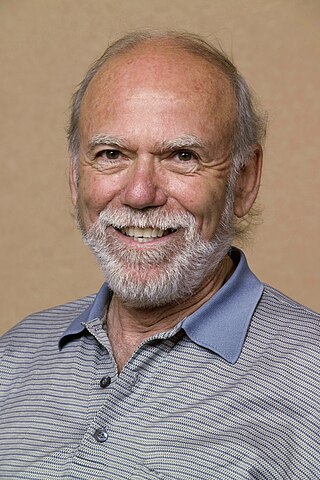Related Research Articles

John Bardeen was an American physicist and electrical engineer. He is the only person to be awarded the Nobel Prize in Physics twice: first in 1956 with William Shockley and Walter Brattain for the invention of the transistor; and again in 1972 with Leon N. Cooper and John Robert Schrieffer for a fundamental theory of conventional superconductivity known as the BCS theory.

Leon Max Lederman was an American experimental physicist who received the Nobel Prize in Physics in 1988, along with Melvin Schwartz and Jack Steinberger, for research on neutrinos. He also received the Wolf Prize in Physics in 1982, along with Martin Lewis Perl, for research on quarks and leptons. Lederman was director emeritus of Fermi National Accelerator Laboratory (Fermilab) in Batavia, Illinois. He founded the Illinois Mathematics and Science Academy, in Aurora, Illinois in 1986, where he was resident scholar emeritus from 2012 until his death in 2018.

The charm quark, charmed quark, or c quark is an elementary particle found in composite subatomic particles called hadrons such as the J/psi meson and the charmed baryons created in particle accelerator collisions. Several bosons, including the W and Z bosons and the Higgs boson, can decay into charm quarks. All charm quarks carry charm, a quantum number. This second generation particle is the third-most-massive quark with a mass of 1.27±0.02 GeV/c2 as measured in 2022 and a charge of +2/3 e.

The Superconducting Super Collider (SSC) was a particle accelerator complex under construction in the vicinity of Waxahachie, Texas, United States.

The DØ experiment was a worldwide collaboration of scientists conducting research on the fundamental nature of matter. DØ was one of two major experiments located at the Tevatron Collider at Fermilab in Batavia, Illinois. The Tevatron was the world's highest-energy accelerator from 1983 until 2009, when its energy was surpassed by the Large Hadron Collider. The DØ experiment stopped taking data in 2011, when the Tevatron shut down, but data analysis is still ongoing. The DØ detector is preserved in Fermilab's DØ Assembly Building as part of a historical exhibit for public tours.
The Mark I, also known as the SLAC-LBL Magnetic Detector, was a particle detector that operated at the interaction point of the SPEAR collider from 1973 to 1977. It was the first 4π detector, i.e. the first detector to uniformly cover as much of the 4π steradians around the interaction point as possible with different types of component particle detectors arranged in layers. This design proved quite successful, and the detector was used in discoveries of the
J/ψ
particle and tau lepton, which both resulted in Nobel prizes. This basic design philosophy continues to be used in all modern collider detectors.

The God Particle: If the Universe Is the Answer, What Is the Question? is a 1993 popular science book by Nobel Prize-winning physicist Leon M. Lederman and science writer Dick Teresi.
Bjørn Håvard Wiik was a Norwegian elementary particle physicist, noted for his role on the experiment that produced the first experimental evidence for gluons and for his influential role on later accelerator projects. Wiik was director of DESY, in Hamburg, Germany, from 1993 until his death.
Stanley George Wojcicki was a Polish American professor emeritus and former chair of the physics department at Stanford University in California.

Barry Clark Barish is an American experimental physicist and Nobel Laureate. He is a Linde Professor of Physics, emeritus at California Institute of Technology and a leading expert on gravitational waves.
The High Energy Physics Advisory Panel (HEPAP) is a permanent advisory committee to the United States Department of Energy and the National Academy of Sciences, created in 1967 and organized under the Federal Advisory Committee Act (FACA) of 1972.
Charles Young Prescott is an American particle physicist.

John Peoples Jr. is an American physicist who served as Fermilab's third director, served as director of the Sloan Digital Sky Survey, and oversaw the shutdown of the Superconducting Super Collider.
Laurie Mark Brown is an American theoretical physicist and historian of quantum field theory and elementary particle physics.
Lillian Hartman Hoddeson is an American historian of science, specializing in the history of physics and technology during the 2nd half of the 20th century.
George H. Trilling was a Polish-born American particle physicist. He was co-discoverer of the J/ψ meson which evinced the existence of the charm quark. Trilling joined the Physics Department faculty at the University of California, Berkeley, in 1960, where he was Department Chair from 1968 through 1972. Trilling was on sabbatical leave to CERN in 1973–74, where he worked on the study of the properties of charm particles, their decay modes and excited states. He was also Director of the Physics Division at the Lawrence Berkeley National Laboratory from 1984 until 1987. Trilling was a principal proponent of the Superconducting Super Collider project and spokesperson for the Solenoidal Detector Collaboration. After the SSC was cancelled in 1993, Trilling transitioned most of the SDC team to collaborate on the ATLAS experiment at the LHC, which led to the discovery of the Higgs boson in 2012. Trilling was elected Vice-President of the American Physical Society, beginning his term on 1 January 1999, and was President of the society in 2001.
Adrienne W. Kolb is an American historian of science who worked for many years as the archivist and historian at Fermilab.
Catherine Lee Westfall is an American historian of science known for her work documenting the history of the United States Department of Energy national laboratories.
Donald J. Summers was a particle physicist who worked on experiments at several labs, including Fermilab, CERN, SLAC, and KEK.
Max Dresden was a Dutch-American theoretical physicist and historian of physics. He is known for his research in "statistical mechanics, superconductivity, quantum field theory, and elementary particle physics."
References
- ↑ "Michael Riordan". University of California, Santa Cruz. Retrieved 10 May 2022.
- ↑ "APS fellow archive". American Physical Society. Retrieved 10 May 2022.
- ↑ "Michael Riordan". John Simon Guggenheim Memorial Foundation. Retrieved 10 May 2022.
- ↑ Stephens, Tim (30 April 2002). "UC Santa Cruz scientist honored for communicating physics". University of California, Santa Cruz. Retrieved 10 May 2022.
- ↑ "AIP Gemant Award Goes to Riordan". Physics Today. 55 (7): 71–72. 2002. Bibcode:2002PhT....55R..71.. doi:10.1063/1.2409340.
- ↑ Reviews of Tunnel Visions include:
- Weart, Spencer (2016). "Tunnel Visions: The Rise and Fall of the Superconducting Super Collider". American Journal of Physics. 84 (4): 318. Bibcode:2016AmJPh..84..318W. doi:10.1119/1.4941930.
- Dylla, H. Frederick (2016). "Tunnel Visions: The Rise and Fall of the Superconducting Super Collider". Physics Today. 69 (3): 52–53. Bibcode:2016PhT....69c..52D. doi: 10.1063/PT.3.3109 .
- Pisano, Raffaele (November 2015). "Tunnel Visions: The Rise and Fall of the Superconducting Super Collider - by Michael Riordan, Lillian Hoddeson and Adrienne W. Kolb". Centaurus. 57 (4): 271–273. doi:10.1111/1600-0498.12107.
- Westfall, Catherine (October 2016). "Tunnel Visions: The Rise and Fall of the Superconducting Super Collider by Michael Riordan, Lillian Hoddeson, Adrienne W. Kolb (review)". Technology and Culture. 57 (4): 1036–1037. doi:10.1353/tech.2016.0138.
- ↑ Rowan-Robinson, Michael (22 August 1991). "In the Beginning -- The Shadows of Creation: Dark Matter and the Structure of the Universe by Michael Riordan and David N. Schramm". Nature. 352 (6337): 677. doi:10.1038/352677a0. ProQuest 204439175.
- ↑ Reviews of The Hunting of the Quark include:
- "The Hunting of the Quark, Michael Riordan. 1987. Simon and Schuster, New York. 399 pages. Index. ISBN: 0-671-50466-5. $21.95". Bulletin of Science, Technology & Society. 7 (4): 451. 1 August 1988. doi:10.1177/0270467688008004120.
- Firestone, Alexander (1988). "The Hunting of the Quark: A Trued Story of Modern Physics". Physics Today. 41 (4): 90–91. Bibcode:1988PhT....41d..90R. doi:10.1063/1.2811393.